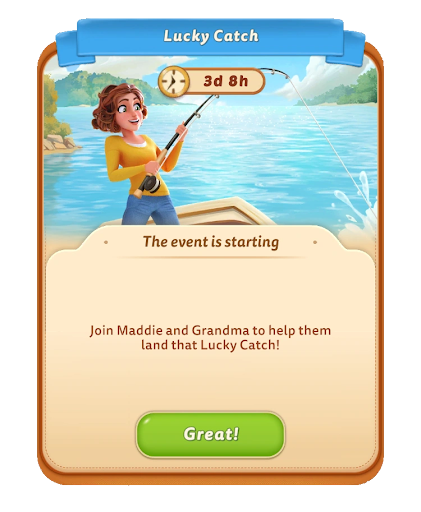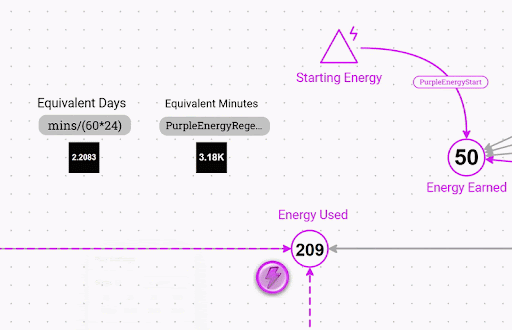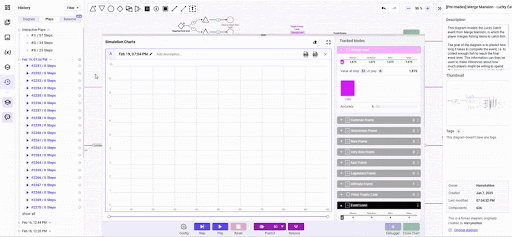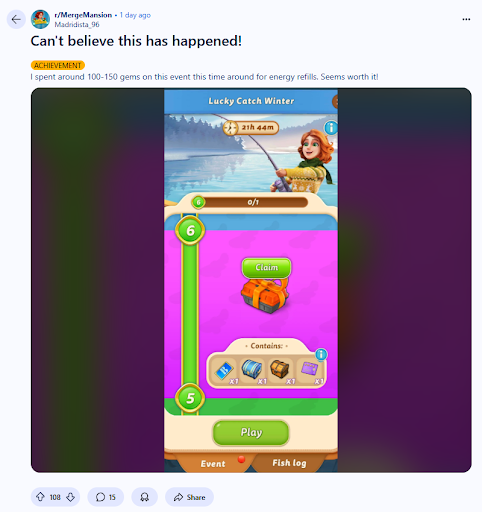Understanding the Event and Showcasing the Problem
Using Monte Carlo simulation powered by Machinations, I was able to determine that Merge Mansion’s original Lucky Catch event is unfinishable.

Having played Merge Mansion quite avidly for over a year, I had plenty of opportunities to try out the seasonal Lucky Catch event, which is regarded rather infamously by the community as the hardest and “most unbeatable” event in the entire game.

The Lucky Catch event challenges players to collect as many fish as possible over a four-day period, with tiered rewards at each milestone.
Though it isn’t essential to collect all the fish (you earn rewards for your main board along the way), community members nevertheless felt cheated that they couldn’t progress further for the effort (and real money) they’d put into it.



My experience of the event was the same: even playing several times a day and using a decent amount of Gems (the game’s hard currency), I still couldn’t get close to completing the event.
I was very curious to find out exactly how much would be required of me – in time or in dollars – to actually complete the event; and as a Machinations user, I had the means to do this.
Why use Machinations
Machinations is a modelling tool that allows you to replicate systems like games, economies or other resource flows.
The benefit of Machinations over other modelling methods, such as Python scripts or spreadsheets, is that the systems are visual.
This living flowchart approach allows you to explore moment-to-moment behaviours in your systems without needing to interrogate formulas or lines of code.
The Model
The model I built simulates the tapping and merging of items in the Lucky Catch side-board.
As the event takes place on a separate board, this made it easy to abstract from the core game.
Though players can buy extra Energy and special fishing items to speed their progress, the game mode is primarily fuelled by passively regenerating Energy, which the player uses to tap and produce items.

This passive Energy usage is what we use to infer how long the event will take to complete, assuming no other sources of Energy are leveraged. If, for instance, it takes 1000 Energy (i.e. 1000 taps) to complete the event, and it takes fifteen minutes to regenerate one Energy, we know that it will take at least (1000*15=) 15,000 minutes (or 10.4 days) to generate enough Energy to perform the requisite taps.
With that minimum time established, we can estimate – based on the Gem costs of Energy refreshes and fishing items in the store – how much these monetisation sinks would contribute to reducing the completion time.
By extension, we can learn how much the player would have to spend to complete the event in time.
Because the game includes randomness, I needed to run the model many thousands of times to capture the full range of possible outcomes for players, all the way from the very lucky to the very unlucky players.

Machinations’ Predictions feature provides this ability: using the Monte Carlo method, the model is run from scratch over and over, standing in as a proxy for thousands of players playing through the game. This can deliver accurate data instantaneously without requiring extensive beta testing.
Assumptions and Disclaimers
Before exploring the results of the simulation, it is important to note that the model is based on assumptions about the inner workings of the game, and as such it is not guaranteed to be perfectly accurate.
Each assumption about the game itself is a potential source of error. This is particularly the case for the assumed drop mechanics for fish. Here, I’ve assumed pure (weighted) randomness in terms of which fish drops: however, it’s possible that the game has some feedback logic which makes fish you have less of drop more often in future.
I accounted for this uncertainty in part by performing “extra-generous” scenarios where key variables like drop rates have been driven to the absolute extreme, thus determining the limits of the system. If even these scenarios don’t produce reasonable completion times, this might indicate that more complex logic might be at work in the game. Alternatively, it could mean that the event truly is this difficult to complete.
There are also behavioural assumptions that must be made about how players behave.
It turns out that in the Lucky Catch event, there is only one core decision the player can make in terms of the items on the board: namely, the level to which they merge their Tackle Box (the item which produces all subsequent fishing items: the higher the level, the higher quality the drops).
In this instance, I simulated each possible scenario and compared the results.
You can see the values I used for the simulation here. Any values highlighted yellow are ones which are assumed.
The Results
With the model and the assumptions in place, I ran a set of simulations. As mentioned above, each simulation assumed a different level to which players upgrade their Tackle Box.
Energy needed to complete the event using each Tackle Box level
The first output of the model was the Energy required to complete the event, which is equivalent to the number of times the player has to tap on items.

Each column represents a different scenario, namely the level up to which the player merges their Tackle Box items. The higher the Tackle Box level, the better the drops obtained from tapping it, but the more Energy it takes to create that Tackle Box.
The average amount of Energy was typically about five thousand.
Days to complete the event using each Tackle Box level
Using the Energy requirements from above, the model calculated how long you’d need to wait to passively generate this much Energy. This gave the maximum time to complete the event for that particular playthrough.

The model suggests that to complete the event (i.e. to collect enough fish of each type), it will take more than two months on average. Remember that the event only lasts for four days in reality.

Looking at the distribution, it also seems that no player was able to complete the event in less than twenty days, which is still five times longer than what the event gives you.
The extremeness of these results was cause for question when I built the model…
Days to complete the event when rare fish are made extremely common
So next, I turned the balancing dial all the way, making rarer fish almost as common as common fish. This, I hoped, would identify whether there was some set of drop rates that would make the event beatable.
But still, the completion time was weeks over the four-day window.

This result indicates that the drop rates probably aren’t the sole reason the event feels unbeatable. From my own observations of players complaining about getting the same fish over and over, it appears unlikely that there is any additional logic that improves the fairness of fish drops.
Accounting for Player Spend
Up to this point, I’d deliberately assumed that the player never purchases any fishing items or Energy refreshes from the store. The next step was to factor in these behaviours, to determine whether these monetisation sinks made a difference.
There are several ways to speed up progress in the Lucky Catch event, the cheapest and most accessible of which give you Energy.
First, I calculated the maximum Energy each Energy-yielding sink can give out, then deducted that from the Energy required to complete the event. This in turn would reduce the time required to complete the event.
Free sources of Energy
Before accounting for the additional sinks, I calculated the maximum amount of Energy the player could collect for free over the four-day period that the event ran.
I then deducted these free sources of Energy from the total amount required to finish the event (as determined in the simulations). This gave me the amount of Energy the player would have to purchase from elsewhere to finish the event in four days.
1. Energy generated passively
2. Plus free Energy offers

Next, I looked at the two “paid” sources of Purple Energy in the shop:
3. Paying Gems to refill Energy

The player can refill their Energy multiple times this way, however the cost doubles each time.
This means that if the player were to use just this sink to complete the event, they’d be spending millions of dollars.

Evidently, this sink is not meant to be the sole way to complete the event. Therefore, I assumed the player would only use this sink a few times a day.
As a result, this particular source of Energy barely had an effect on reducing the time to complete the event.
4. Normal Energy conversion

The second paid Energy source allows you to turn the Energy used for the main board into Purple Energy used for Lucky Catch.

Even combined with the previous sink, this sink can’t provide enough Energy to make a serious impact: over three thousand Energy is still needed, which equates to around fourty days’ worth of passively generated Energy.
We must therefore conclude that all of the above sinks combined aren’t enough to complete the event on average, and that perhaps other sinks need to be used.
Buying extra fishing items
Instead of buying Energy, the player can buy fishing items. Most of these items are fishing rods, which produce fish.

By buying fishing rods instead of creating them through normal gameplay, the player not only gets a fish instantly, but they also don’t have to spend their Energy creating the items that in turn create fishing rods. This saves them a lot of Energy usage, at the cost of using up a lot of Gems.
To test what effect buying fishing rods had on the time to complete the event, I modified the model so that the player constantly buys fishing rods. This was another case of turning the simulation dials to the max to figure out what the constraints were.
In addition, because there is no longer a need for them to waste Energy creating their own fishing rods, the player taps on nothing except fishing rods and other rare items. By doing so, they are effectively ignoring the core game loop.

Even by doing this, the player still can’t complete the event in time.

In addition, were the player to actually do this, they would have to spend $460 on average: all to not even complete the event.

Using every sink
Determined to find a way to make the event completable, I took the results of the previous test, where the player massively overspends on fishing rods, and assumed they also bought Energy refreshes with Gems.

It turns out that this combination works: by spending just 105 gems on energy refreshes over the event, plus the $460 in fishing rods, the event could be completed in time.
Despite only adding roughly $1 to the total spend, the reason Gem refreshes are necessary here is because you still need some Energy to tap the fishing rods which produce the fish. After collecting a fish, you also need some Energy to create the trophies that give you event progress. Thus, if you expend all the free Energy given throughout the event, you need to make up that extra Energy by buying some more.
How to Beat Lucky Catch
While the model proves that Lucky Catch is technically completable, this is by no means good news. To complete the event, the player would likely have to pay hundreds of dollars on fishing rods in the shop.
But since the core loop of Lucky Catch – the thing that players will spend most of the time doing – is tapping and merging items which produce fishing rods, we can only conclude that the best way to beat Lucky Catch is to not really play it at all.
If the only way to complete the event is to ignore the vast majority of the core experience, can it really be said that the event is “beatable” in any way that matters to players?
For the average player, who will spend a few Gems but who knows their limits, it appears nearly impossible to complete the event: this remains the case even after turning several simulation dials to the extreme, such as the generosity of drop rates.
While I suspect the reality is somewhat less extreme than what the model predicts, it’s still probably an order of magnitude beyond what the average player can sensibly do: a conclusion which is supported almost unanimously by players in r/MergeMansion.
What went wrong with Lucky Catch?
As an economy designer familiar with how game development works, I personally doubt the impossibility of this event was by design. In the current game development climate, it’s easy to see a malicious cash-grabbing scheme where there may just be an oversight.
This particular oversight was probably facilitated in part by heavy workloads and tight deadlines: constant companions of any highly successful live service game.
With all this being said, the number of times the Lucky Catch event has been run leads me to believe that it’s at least financially successful enough to not be swapped out for some other, better balanced event.
This says to me that Metacore was either (1), not aware of the extremeness of the design and were simply looking at high-level performance indicators to judge its success; or (2), the content development treadmill kept the designers from being able to return to it and address it.

All this is not to excuse the problems with this event and others like it: I’ve seen several examples on Reddit of how frustrating and psychologically exploitative these mechanics can feel, leading some to enter addictive cycles or to overspend.
Part of the reason I’ve cut back on my own gaming habits in recent months is that mobile games in particular can become too fun and addictive, to the point that impossible events and grindy content are no longer reasons to quit, and in fact tease out even more engagement: what begins as a fun game to pass the time turns into a Skinner box. I believe it’s game companies’ responsibility to factor ethical practice into their analysis when attempting to measure the performance of their games, and to keep in mind that even poorly designed systems can cause harm.
A Sign of Hope
Since I built this model, Metacore has expanded on the Lucky Catch formula with a new event, called Lucky Snap. However, the standard Lucky Catch event is still being run on occasion.
Perhaps this recent Reddit post is cause for optimism: finally, at least one person has been able to finish the event.

Something has clearly changed in the design. But whether it’s enough to placate a community of frustrated players remains to be seen.
Webinar Recording
If you want to go through this content in video format, watch this recorded session. Bonus: we’re answering audience questions in the last section of the video. Enjoy!



